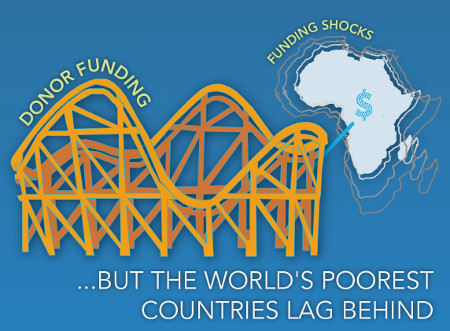
Given the inherent time lag between the inception of research and the adoption of its results, research funding needs to be both stable and sustained over time, but this is far from the case in many countries. To assess funding volatility across countries and regions, and to identify the main causes of funding shocks, ASTI calculated volatility coefficients, quantifying shifts in agricultural R&D spending levels, for 85 countries worldwide. Countries with few or no changes in yearly spending levels or those with steady positive or negative growth have low volatility coefficients (values nearing 0), whereas those with erratic fluctuations in spending levels have high volatility coefficients (values nearing 0.20).
During 2000 - 2008, spending levels in low-income countries were twice as volatile as those of high-income countries (0.21 compared with 0.11) and considerably more volatile than those of middle-income countries (0.14). In addition, average volatility in Africa south of the Sahara (0.21) was much higher than in other developing regions. Although volatility is driven by a variety of factors across countries, the main driver of volatility of Africa south of the Sahara has been the short-term, project-oriented nature of donor and development bank funding.
Although volatility is driven by a variety of factors across countries, the main driver of volatility in Africa south of the Sahara has been the short-term, project-oriented nature of donor and development bank funding. Severe volatility in R&D funding impedes the continuity and hence viability of research programs. In addition to financial challenges, many R&D agencies in low-income countries lack the necessary human, operating, and infrastructural resources to successfully develop, adapt, and disseminate science and technology innovations.
Back to ASTI Global Assessment
ASTI tool: Global Assessment CSS
Instance: No further settings
